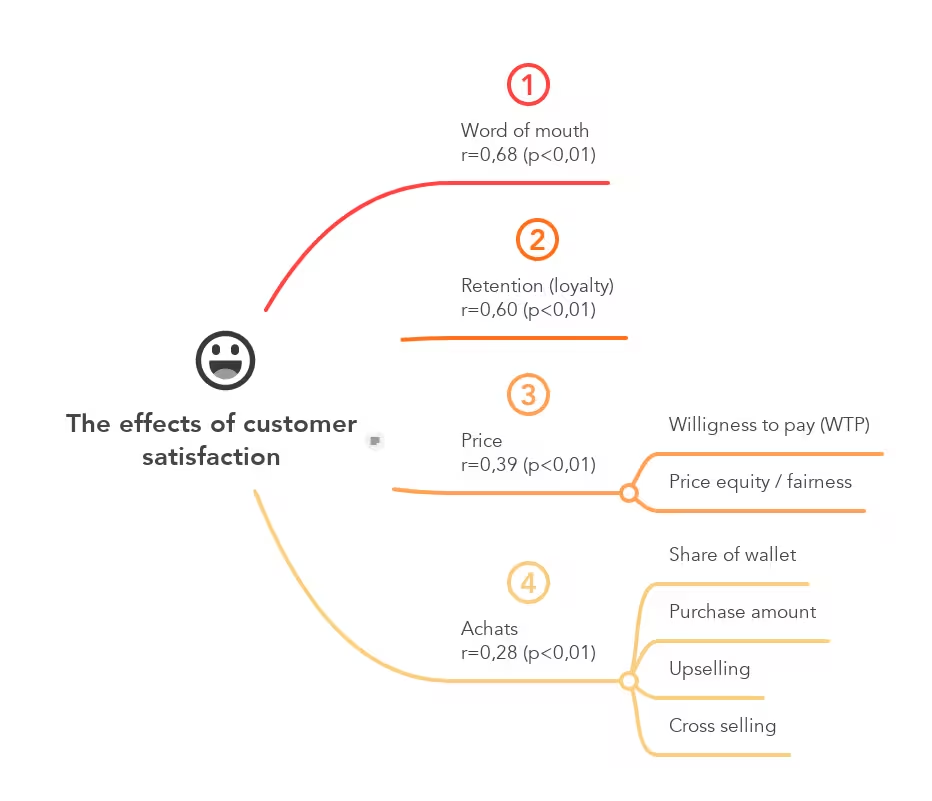In this article, I explain why, despite the current economic climate and the dominance of the “price” factor, customer satisfaction remains the #1 indicator for any company. But you still need to know how to measure it.

Inflation has prompted customers to rethink their consumption habits. In a tight budgetary context, building customer loyalty is becoming increasingly complicated. This raises the question of whether there is any point in trying to satisfy customers (and measure their satisfaction) since price plays an increasingly dominant role in purchasing decisions.
Contact IntoTheMinds marketing agency
If you only have 30 seconds
- A meta-analysis of 245 customer satisfaction studies shows that satisfaction strongly influences customer loyalty. The correlation coefficient is 0.60.
- However, word-of-mouth remains the most important effect in terms of correlation (0.68).
- The effect of customer satisfaction on loyalty is 2 times higher than on the act of purchase (0.60 vs. 0.28).
- Satisfied customers project themselves into a long-term relationship with the company without guaranteeing exclusivity for their purchases. It’s a question of reasoned loyalty.
- The combined effect on loyalty and word-of-mouth makes customer satisfaction the indicator of choice to monitor within the company. However, we must go beyond the Net Promoter Score (NPS) to realize its full impact.
Marketing benchmarks increasingly blurred
In 2024, marketers’ work has never been more complicated. The global economic situation is complicated (persistent inflation in some countries, high interest rates, increased competition). Consumers are constrained in their choices, leading them to make trade-offs.
A survey conducted in 2023 showed that
- 87.5% of French people felt they were affected by inflation
- 70% felt that their income did not allow them to give food the importance they considered necessary.
Apart from food, all sectors are affected. I’ve spoken here of the collapse of the non-food sector and the boom in second-hand goods.
In other words, consumers are having to make choices, and these choices are being made at the expense of past habits. Price is becoming a focal factor, and we can legitimately wonder what role marketing can still play.
This leads me to the question I’d like to develop in this article: Should customer satisfaction still be a priority for companies, or should they focus solely on price? To answer this question, I will start from a well-known (and logical) paradigm: in the long term, a company’s success comes from its ability to retain customers.
Customer satisfaction: still the best predictor of loyalty
There have been so many market research studies on customer satisfaction over the past 40 years that it takes time to draw general conclusions. Fortunately, there are meta-analyses, i.e., analyses of analyses. One such study synthesized the results of 245 customer satisfaction research projects, covering a total sample of N=1160982. Given the size of this sample, the results are very robust.
What does it conclude? Customer satisfaction continues to have a powerful effect on customer loyalty, but other effects must be considered. I’ve summarized the 4 most important effects in the graph below.
The graph above shows 4 of the most frequently covered effects of satisfaction:
- Retention: the company’s ability to keep customers by satisfying them.
- Word-of-mouth: the willingness of customers to speak well (or poorly) of the company once they’ve been satisfied (or dissatisfied).
- Purchases: the effect of satisfaction on the type and number of purchases made
- Price: how satisfaction alters the customer’s perception of price
The “r” factor indicates the “strength” of the correlation between the 2 variables. You can see that the strongest effect is on word-of-mouth, immediately followed by loyalty. The correlation is 0.6, which means that for every percentage of satisfaction gained, you will gain 0.6 percentage points of loyalty. It’s probably abstract, but it’s extremely high
Contact the IntoTheMinds agency for your customer satisfaction surveys
A loyal customer but spaced-out purchases
The results of the meta-analysis also show that the effect of customer satisfaction on purchases is 2 times weaker than on retention (0.28 versus 0.60). How is this possible?
Although we must be incredibly careful with the interpretations of meta-analyses, a satisfied customer wants to remain a customer rather than necessarily buy more proportionally. Granted, that’s abstract. I’m going to venture into a more business-oriented interpretation. A satisfied customer will remain loyal over the long term but retains a degree of volatility that allows him to be unfaithful and spend his money elsewhere. In other words, even if a loyal customer spends more with you, that doesn’t guarantee you’ll get their entire budget.
Is it still profitable to invest in customer satisfaction?
Despite complicated market conditions, customer satisfaction remains the key indicator a company should track. This raises many questions about how to track this indicator, as most companies rely on Net Promoter Score (NPS) and need help understanding what to do with it. NPS has several drawbacks, which have led some to suggest that companies should abandon it. This is a dream.
Why does customer satisfaction remain the #1 indicator? The retention aspects, of course, and the word-of-mouth effects are even stronger (r=0.68 versus r=0.60). Word-of-mouth is the most interesting effect because it multiplies sales opportunities.
Human beings are far from rational in their decisions (see Kahneman‘s work on this subject), and a recommendation from someone you know will always constitute an interesting “nudge.”
In short, I’d say that customer satisfaction is a double lever:
- It helps you keep customers longer
- It enables you to find new prospects through word-of-mouth.
Please feel free to comment and share this article. You can contact us here to ask us your questions directly.
Posted in Research.


